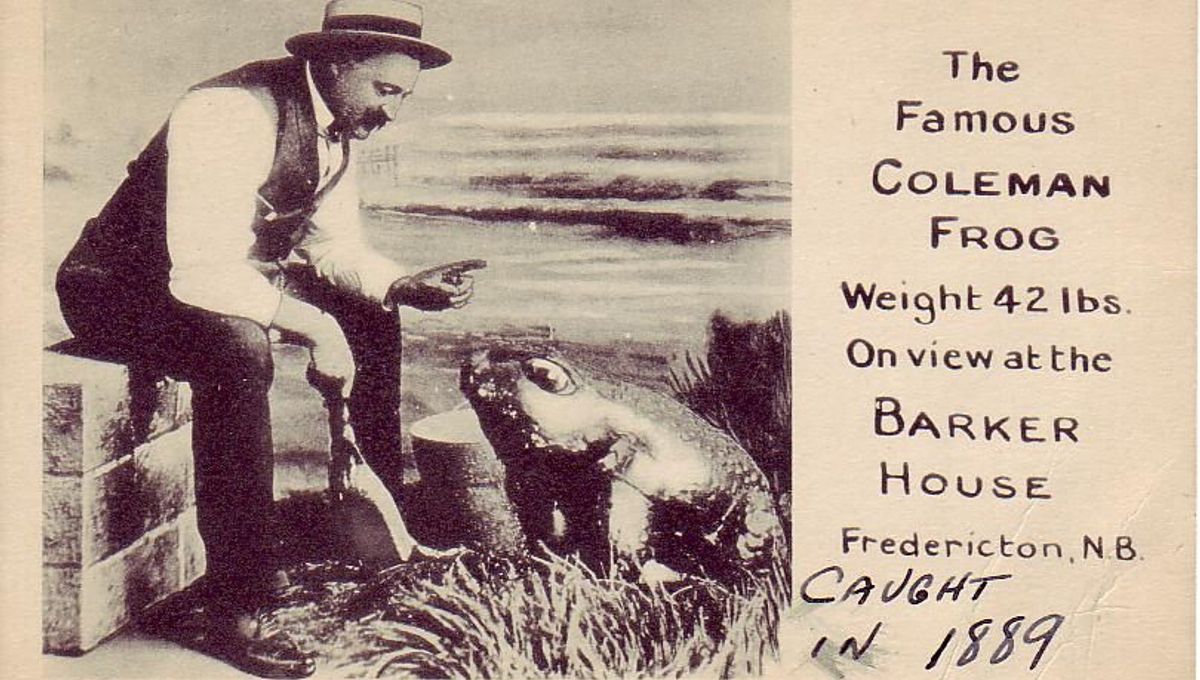
Every small town has its local legend. In Inverness, Scotland, it’s Nessie; in Ocracoke, North Carolina, it’s Blackbeard. In Fredericton, New Brunswick, it’s… well, it’s a little different.
It’s a massive, taxidermized frog.
“People come from all over the world to see it,” said Penny Pacey, then manager of the Fredericton Region Museum in Fredericton, New Brunswick, Canada, in a 2007 report by the Regina Leader-Post.
She “is a well-known piece of Fredericton folklore,” Pacey said; “an artifact dating back well over 100 years and world-famous.”
Known as the Coleman Frog, or Cornelia Webster if you’re acquainted, the bullfrog’s story goes back to 1885, when a local guy named Fred Coleman caught her in Killarney Lake. At the time, she was the size of a regular frog, according to the legend, but after eight years of being fed cornmeal, baked beans, June bugs, whey, buttermilk, and whiskey, she topped the scales at a whopping 19 kilograms (42 pounds) – more the size of a bulldog than a bullfrog.
In fact, that wasn’t the only way this mega-amphibian apparently resembled a faithful four-legged friend. She apparently would come when called by Fred, or upon the sounding of a dinner bell, and entertained his guests with feats such as towing canoes and racing cats.
Eventually, she died in a mysterious “dynamite accident”, at which point Coleman sent her remains to a taxidermist. Her body was displayed in the lobby of the Barker House Hotel, which Coleman owned, for several years, where patrons reportedly used her as an ashtray.
It’s for this reason, perhaps, that the exhibit currently on display in the Fredericton Region Museum looks kind of nothing like either a real frog or the photo “evidence” that exists of Cornelia during her lifetime. “The frog was ‘repaired’,” explains a 2009 blog post from the York Sunbury Historical Society, “and painted [the] unnatural green color that it has now.”
Now, we know what you’re thinking, and yes: normally, we’d be a bit more skeptical about a story involving an old-timey frog that inexplicably grew more than 40 times the size of its species average on a diet that should by rights have killed it, and the only evidence for its existence being a very suspect taxidermy that nobody is allowed to inspect and a photo of what is pretty clearly a different, and possibly also fake, frog.
And, you know what? Now we’ve written it out like that, the whole thing does seem quite suspect.
“This is all nonsense, you know,” laughed David Green, director of the Redpath Museum at Montreal’s McGill University and a specialist in vertebrates.
Whiskey would most likely kill the frog, he told the Post – in fact, frogs don’t even drink through their mouths like we do; they absorb moisture through the skin around their belly and thighs.
So, if not a real frog, then what could the body in the museum actually be? Well, some cynics have suggested that Coleman “had simply bought a display item which had been used to advertise a cough medicine guaranteed to relieve ‘the frog in your throat’,” wrote Joe Nickell in a 2000 article for the Skeptical Enquirer, before pointing out that the “frog” appeared to have “a ‘fabric impression underneath’ [the skin] and indeed ‘a yellowed canvas’ visible through some cracks.”
Add to that the fact that the froggie feet were apparently made from wax, and, he concluded, “the overall effect is of a fabricated item, especially considering the canvas.”
So, is the Coleman frog a fake? “It’s difficult to say,” the York Sunbury Historical Society concludes, rather optimistically.
But real or not, it’s certainly a popular legend. “People and crowds huddle around to have their picture taken with this wonder,” the Society says, “and many walk away believers.”
Source Link: The "Coleman Frog" Was A Massive, Whiskey-Swilling, Baked-Beans-Eating, Canadian Bullfrog